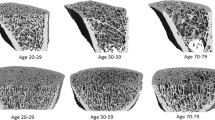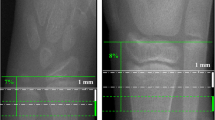Abstract
Introduction
An advanced method of analyzing the cortical bone microarchitecture of the distal radius using high-resolution peripheral quantitative computed tomography (HR-pQCT) was developed.
Materials and methods
The subjects were 60 women (20: aged 30–49, 20: aged 50–69, and 20: aged 70–89 years). The distal radius was scanned by HR-pQCT, and its cortical volumetric bone mineral density (Ct.vBMD), cortical porosity (Ct.Po), and cortical thickness (Ct.Th) were measured. The cortical bone was also divided into three areas according to whether its thickness was < 0.5 mm, 0.5–1.0 mm, or > 1.0 mm, and the percentage of each surface area in the total surface area of cortical bone was calculated (Ct.Th (<0.5), Ct.Th (0.5–1.0), Ct.Th (>1.0), respectively). The cortical bone at the distal radius was further segmented into dorsal, palmar, radial, and ulnar sides, and the above-described parameters were measured in these regions.
Results
Integral analysis showed that Ct.vBMD and Ct.Th decreased and Ct.Po increased with age (R = − 0.62, − 0.55, and 0.54). Ct.Th (< 0.5) expanded with age (R = 0.49), with the rate of change between those aged 30–49 years and those aged 50–69 years being 106.7%. On regional analysis, the expansion of Ct.Th (< 0.5) with age was particularly marked on the dorsal and palmar side (R = 0.51 and 0.49), where the rate of change between those aged 30–49 years and those aged 50–69 years was the highest, at 196.1 and 149.6%.
Conclusion
The method to identify areas of cortical bone thinning in the segmented regions of the dorsal, palmar, radial, and ulnar sides of the distal radius using HR-pQCT may offer a sensitive assessment of age-related deterioration of cortical bone.






Similar content being viewed by others
References
Burge R et al (2007) Incidence and economic burden of osteoporosis-related fractures in the United States, 2005–2025. J Bone Miner Res 22:465–475
Sakuma M, Endo N, Oinuma T, Miyasaka D et al (2014) Incidence of osteoporotic fractures in Sado, Japan in 2010. J Bone Miner Metab 32:200–205
Sontag A, Krege JH (2010) First fractures among postmenopausal women with osteoporosis. J Bone Miner Metab 28:485–488
Court-Brown CM, Caesar B (2006) Epidemiology of adult fractures: a review. Injury 37:691–697
Burghardt AJ, Link TM, Majumdar S (2011) High-resolution computed tomography for clinical imaging of bone microarchitecture. Clin Orthop Relat Res 469:2179–2193
Cheung AM, Adachi JD, Hanley DA, Kendler DL, Davison KS, Josse R, Brown JP, Ste-Marie L-G, Kremer R, Erlandson MC, Dian L, Burghardt AJ, Boyd SK (2013) High-resolution peripheral quantitative computed tomography for the assessment of bone strength and structure: a review by the Canadian Bone Strength Working Group. Curr Osteoporos Rep 11:136–146
Nishiyama KK, Shane E (2013) Clinical imaging of bone microarchitecture with HR-pQCT. Curr Osteoporos Rep 11:147–155
Manske SL, Zhu Y, Sandino C, Boyd SK (2015) Human trabecular bone microarchitecture can be assessed independently of density with second generation HR-pQCT. Bone 79:213–221
Chiba K, Okazaki N, Kurogi A, Isobe Y, Yonekura A, Tomita M, Osaki M (2018) Precision of second-generation high-resolution peripheral quantitative computed tomography: intra- and intertester reproducibilities and factors involved in the reproducibility of cortical porosity. J Clin Densitom 21:295–302
Chiba K, Okazaki N, Isobe Y, Miyazaki S, Yonekura A, Tomita M, Osaki M (2021) Precision of 3d registration analysis for longitudinal study of second-generation HR-pQCT. J Clin Densitom 24:319–329
Yokota K, Chiba K, Okazaki N, Kondo C, Doi M, Yamada S, Era M, Nishino Y, Yonekura A, Tomita M, Osaki M (2020) Deterioration of bone microstructure by aging and menopause in Japanese healthy women: analysis by HR-pQCT. J Bone Miner Metab 38:826–838
Bonaretti S, Majumdar S, Lang TF, Khosla S, Burghardt AJ (2017) The comparability of HR-pQCT bone measurements is improved by scanning anatomically standardized regions. Osteoporos Int 28:2115–2128 (Springer London)
Whittier DE, Boyd SK, Burghardt AJ, Paccou J, Ghasem-Zadeh A, Chapurlat R, Engelke K, Bouxsein ML (2020) Guidelines for the assessment of bone density and microarchitecture in vivo using high-resolution peripheral quantitative computed tomography. Osteoporos Int 31:1607–1627
Sode M, Burghardt AJ, Pialat J-B, Link TM, Majumdar S (2011) Quantitative characterization of subject motion in HR-pQCT images of the distal radius and tibia. Bone 48:1291–1297
Pialat JB, Burghardt AJ, Sode M, Link TM, Majumdar S (2011) Visual grading of motion induced image degradation in high resolution peripheral computed tomography: impact of image quality on measures of bone density and micro-architecture. Bone 50:111–118
Burghardt AJ, Buie HR, Laib A, Majumdar S, Boyd SK (2010) Reproducibility of direct quantitative measures of cortical bone microarchitecture of the distal radius and tibia by HR-pQCT. Bone 47:519
Hildebrand T, Rüegsegger P (1997) A new method for the model-independent assessment of thickness in three-dimensional images. J Microsc 185:67–75
Carballido-Gamio J, Bonaretti S, Kazakia GJ, Khosla S, Majumdar S, Lang TF, Burghardt AJ (2017) Statistical parametric mapping of hr-pQCT images: a tool for population-based local comparisons of micro-scale bone features. Ann Biomed Eng 45:949–962
Sode M, Burghardt AJ, Kazakia GJ, Link TM, Majumdar S (2010) Regional variations of gender-specific and age-related differences in trabecular bone structure of the distal radius and tibia. Bone 46:1652–1660
Kazakia GJ, Nirody AN, Bernstein G, Sode M, Burghardt AJ, Majumdar S (2012) Age- and gender-related differences in cortical geometry and microstructure: improved sensitivity by regional analysis. Bone 52:623–631
Funding
None.
Author information
Authors and Affiliations
Contributions
Study design: KC; data acquisition: SO and NO; data analysis: SO and KC; data management: SO; statistical analysis: SO; data interpretation: SO, KC, AY, MT, and MO; drafting of the manuscript: SO and KC; revision of the manuscript content: KC and MO; approval of the final version of the manuscript: SO, KC, NO, AY, MT, and MO.
Corresponding author
Ethics declarations
Conflict of interest
None.
Ethical approval
Nagasaki University Hospital Clinical Research Ethics Committee (registration numbers: 15083105).
Informed consent
Obtained.
Additional information
Publisher's Note
Springer Nature remains neutral with regard to jurisdictional claims in published maps and institutional affiliations.
About this article
Cite this article
Ota, S., Chiba, K., Okazaki, N. et al. Cortical thickness mapping at segmented regions in the distal radius using HR-pQCT. J Bone Miner Metab 40, 1021–1032 (2022). https://doi.org/10.1007/s00774-022-01370-2
Received:
Accepted:
Published:
Issue Date:
DOI: https://doi.org/10.1007/s00774-022-01370-2




